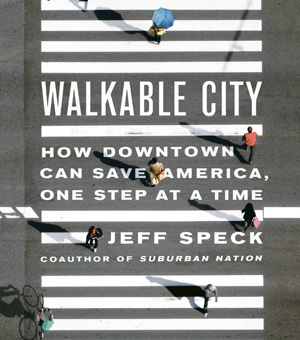Jeff Speck’s new book, Walkable City: How Downtown Can Save America, One Step at a Time, is a damning attack on suburban sprawl, obesity, car-culture America and the entire profession of traffic engineers, all of which he claims is interconnected. Fully acknowledging that cars are an important part of American life, Speck, who doesn’t hate them, presents a logical rallying cry for a complex set of issues related to walkability. As we move into a future dominated by urbanism, he claims, inner cities must prioritize pedestrian-friendliness or else no one will want to live in them.
The way I see it, the timing of this book is perfect, because for decades in San Jose, it seems the apparatus of planning has been implemented to make cars happy and people miserable. And if this town wants to have a reputable urban center, then that urban center must be attractive, safe and interesting for pedestrians. That doesn’t mean anti-automobile. It just means all dimensions of planning—from high-rises down to the gutters—should incorporate walkability.
From Speck’s point of view, it’s all the traffic engineers’ fault. In fact, he spends half of the book systematically eviscerating every idea that has ever sprung from the brains or mouths of traffic engineers. Every scheme they envision, Speck says, is exactly backward and counterintuitive.
For example, everyone complains about traffic congestion, so we build more freeways and widen more roads, which, of course, does nothing but create more room for more cars and thus more traffic congestion. Speck dismisses this as “induced demand.” That is, the habitual behavior of widening roads, adding more highways and reaming out downtowns to increase traffic flow doesn’t work. It causes more congestion, makes cities less safe and decreases the quality of life.
In city traffic, the common practice of widening lanes and chopping sidewalks in half to make things safe for higher-speed driving seems nonsensical, but according to Speck, this is precisely what traffic engineers do. The practice actually causes the speeding it hopes to protect against.
Another example involves push-button signal crossing. Speck says that in his experience, cities with push-button crossings are almost always the cities that are the most screwed up. Again, the idea is counterintuitive. Most assume push-button crossing helps the pedestrians, but Speck says it’s there as a result of a city not being pedestrian friendly to begin with. “Far from empowering walkers,” he writes, “the push-button turns them into second-class citizens; pedestrians should never have to ask for a light.” If the neighborhood were safe, attractive and interesting enough for pedestrians to fill the sidewalks in the first place, there wouldn’t be any need for the push-buttons.
By Jeff Speck



